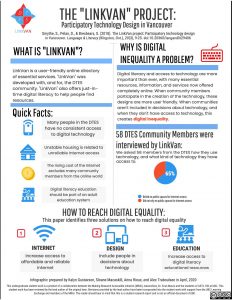Shannon Murray
Graduate Academic Assistant with STOREE and the UBC Learning Exchange
In my role as a Making Research Accessible initiative (MRAi) Student Librarian, and a Graduate Research Assistant for STOREE, I’ve been focusing on how to better share the research materials that are added to the Downtown Eastside Research Access Portal (DTES RAP). As a placed-based, community-focused portal, the RAP is interested in determining how to better interact and communicate research with its users – and infographics are one genre that support this kind of knowledge mobilization and exchange due to their visual (and often aesthetically-pleasing) nature. As a part of my work, I collaborated with the UBC Learning Exchange, UBC Library, STOREE and UBC Public Humanities Hub to create an Infographics Toolkit to help researchers, faculty, students and more learn the whys and hows of infographic creation. Alongside the Toolkit, the Public Humanities Hub hosted a moderated discussion with UBC Professors and Knowledge Exchange experts to discuss the various components of infographics.
Infographics as Public Scholarship
The Infographics Toolkit features a few distinct sections: Infographics as Advocacy, Infographics as Pedagogy, Infographics as Research, and Infographic Creation. Each section delves into a unique aspect of infographics – as they can be used as an advocacy tool, in the classroom, and as a way to share research with a wider audience and community outside a specific field of study. The toolkit provides a step-by-step guide to creating an infographic – providing suggestions for language, design, and the visual elements. Creating an infographic isn’t an easy process, and requires careful consideration – so, in creating the toolkit, the goal was to simplify the process and provide the guidance (and resources) that would assist anyone in their goal of creating an accessible, and attractive, infographic.
The creation of the Toolkit was a team effort and involved a number of different UBC departments, including the UBC Learning Exchange and UBC Library in partnership with UBC’s Public Humanities Hub. Beyond these key departments, the toolkit involved expertise and insight from panelists and advisors – Dr. Evan Mauro, Dr. Kirby Mania, Dr. Valerie Hruska, Dr. Lupin Battersby, Dr. Heather O’Brien, and Nick Ubels. Everyone involved brought a unique perspective and helped to exemplify the importance of visual, alternative genres and the need for a pointed focus on knowledge mobilization. From a student perspective, creating the toolkit affirmed my desire to make research more accessible and to advocate for more inclusive ways to share the work that is being done at universities.
One of the student-created infographics from the MRAi/ASTU 100 partnership
For more information and other resources about infographics, check out my final project for LIBR 596: Professional Experience. This project was completed last summer and kicked off my work with STOREE. It allowed me to get some hands-on experience helping first-year students create their own infographics for the DTES RAP and sparked my interest in knowledge mobilization and exchange! This interest will follow me into my post-graduation Librarian role, as I continue to work with students and share my perspective and understanding of knowledge mobilization and the importance of accessible research genres.
